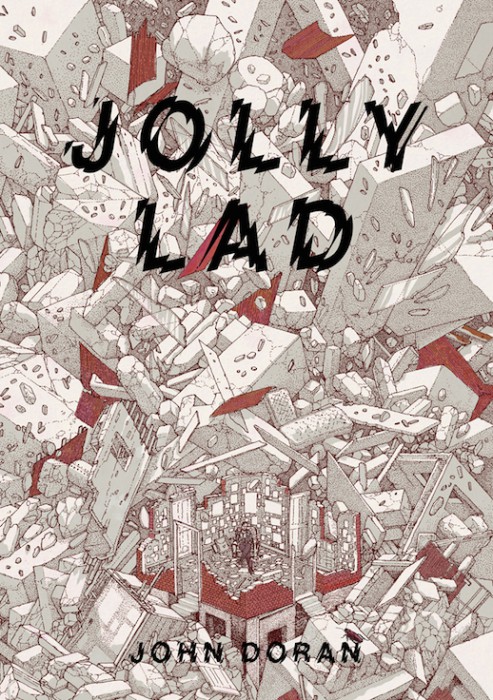Jolly Lad by John Doran
Strange Attractor Press, 269 pages, hardback and paperback. Out now.
Review by Roy Wilkinson
This compelling memoir spans Merseyside, dead-end jobs and music journalism – and alcohol, lots of alcohol. Booze’s conjunction with the arts is well-established – Ernest Hemingway, Dorothy Parker, Jackson Pollock. And not forgetting Iron Butterfly’s In-A-Gadda-Da-Vida, a title that, the story goes, stems from a suds-soaked attempt by singer Doug Ingle to communicate the phrase “in the Garden of Eden”. Yet, alcohol’s connection with human endeavour stretches beyond its familiar potency as psychoactive mind-mangler. In the early 20th century, Tour de France riders used alcohol as a pain-killer – alongside a chemical cocktail that included amphetamine, cocaine, strychnine and, yes, nitroglycerine. John Doran’s story kind of combines this Tour self-prescription with Iron Butterfly’s 17-minute rock battering ram.
In the mid 20th century John is writing for Metal Hammer magazine. He looks a bit like a younger British version of Rick Rubin and is very much on trend with the tradition of hairy, heavy-metal hooch-hitting. But, alongside the hard-rock realm’s ongoing attempt to reincarnate the “wrecker of mead-benches” vibe from Beowulf, there’s another strand here. Like those Tour cyclists John is a highly functioning alcohol-user. And he augments his boozing – and then his abstinence – with a pharma-copia that includes cocaine, speed, MDMA, diazepam, opium, marijuana, ketamine, mephedrone and SSRI anti-depressants.
John first realises his unusual affinity with alcohol as a 13-year-old drinking supermarket lager in Rainhill, just outside St Helens on Merseyside: “The sun’s rays slide into my mouth… I always knew there was something missing inside of me… and now Compass lager had given it to me.” He says he was drinking every day by the time he was 15, staying constantly drunk until he was 37. Bleakness and peril accompany John’s perma-boozing. Misadventure and post-pub beatings make A&E a semi-regular end-of-evening destination. At an Iron Maiden show the backstage hospitality area features a whole free pub. John orders 15 cocktails – for himself. Afterwards there’s more drink as he attempts to interview the support band at their hotel. Unable to formulate much in the way of questions, he’s thrown out by security while his coat, phone and wallet remain inside. Outside he’s intercepted by knife-wielding muggers. In his blasted oblivion he circumvents this by grabbing the knife, leaving him bleeding as his astonished assailants send him crashing into a pile of bin bags. But, through all the carnage, self-disgust and broken relationships, Doran doesn’t pursue the desolate diminuendo of the misery memoir. As he says, “I had a really good time drinking.”
The book’s backdrop includes a comprehensive education where there was an average of one CSE/GCE pass per pupil, and a teenage assault that leaves Doran almost blind in one eye. He’s thrown out of Hull University, moving on to warehouse work and, eventually, the traditional courts-and-shorthand entry to journalism, the NCTJ (the National Council for the Training of Journalists). It might all read as moderate-to-interesting local colour if it wasn’t for the sheer scale of his drinking, and the fact John co-founds the much-loved music website The Quietus. But, while there are amusingly adversarial encounters with Bobby Gillespie, there’s not much more on the music industry than there is on an exploding aerosol factory. The key to the book’s power and incision is Doran’s calm, reflective, procedural account of the alcohol addiction that comes close to killing him. He says alcoholism is “debt consolidation for your life” – a liquid expanse in which bills, depression and all quotidian anxieties can be immersed and hidden. But, in one of several memorable metaphorical examinations of alcoholism, Doran points out that once you stop drinking and drain this reservoir you’re suddenly amid another kind of vulnerability, staring at the remains of everything that was consumed in the flood: “The water was merely the stuff that was making things look picturesque… in its place is an area of outstanding natural horror.”
The Quietus is still with us and so is John – his eventual stabilisation catalysed by the birth of his son. This hope-from-chaos is reflected in the book’s impressive physical presence. Inside there are illustrations by Krent Able – maybe best known for his pop-horror comic strips for the Stool Pigeon – while the limited-edition hardback comes with a CD featuring John reading to bespoke backing tracks from musicians including the Manics’ Nicky Wire, Teeth Of The Sea and members of British Sea Power. The cover illustration is an exploding-buildings spectacular by Simon Fowler, who’s created images for musicians including Sunn 0))) and The Bug. Inside the shattering concrete is an image of the author today – suit, neat haircut, stoic in the midst of it all.
Jolly Lad is on sale in the Caught by the River shop, priced £14.
